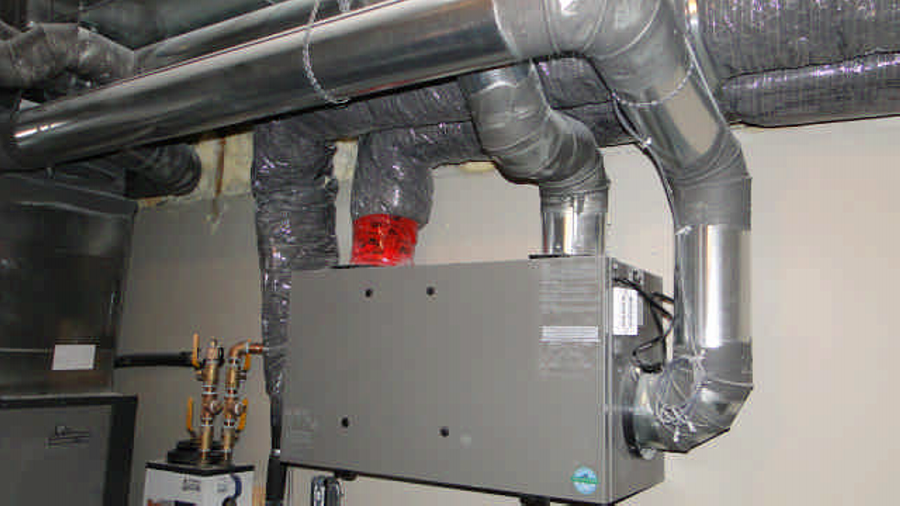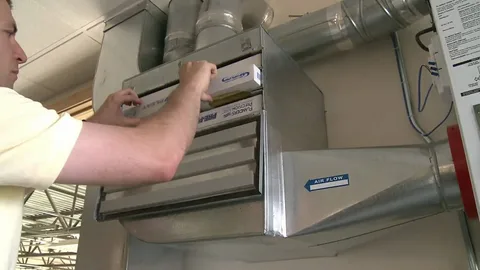Are you looking for ways to reduce your energy bills and improve sustainability in your home or business? Look no further than mechanical heat recovery. By harnessing the power of heat recovery, you can significantly slash your energy costs and minimise your environmental impact. In this blog post, we will explore the benefits of heat recovery systems, the different types available, and how you can implement them in your property. Let’s dive in and discover how heat recovery systems can revolutionise your energy efficiency.
Understanding the Basics of Mechanical Heat Recovery System
Mechanical heat recovery systems serve as a cornerstone in the pursuit of enhancing energy efficiency within buildings, both commercial and residential. The principle upon which these systems operate is fundamentally centred around capturing heat that would traditionally dissipate into the environment and repurposing it to warm incoming fresh air.
This process is facilitated by a network of vents and a heat exchanger – a device that transfers heat from the outgoing stale air to the incoming fresh air without mixing the two air streams. The brilliance of this technology lies in its ability to utilise energy that would otherwise be lost, thereby significantly reducing the demand on heating systems to maintain a comfortable indoor temperature.
In essence, mechanical heat recovery system embody a sustainable approach to heating and ventilation, contributing to a substantial decrease in energy consumption. This aligns with the objectives of reducing carbon emissions and translates into tangible savings on energy bills. The deployment of such systems is a testament to the merging paths of ecological responsibility and economic prudence, presenting a compelling case for their adoption to achieve greater energy sustainability. Their application across diverse settings underscores their versatility and efficacy in harnessing free heat, reinforcing their position as an invaluable component in the quest for improved energy efficiency.
The Environmental and Financial Benefits of Heat Recovery
Heat recovery systems present a dual advantage, striking a delicate balance between ecological stewardship and economic sensibility. They operate on the principle of repurposing waste heat, which would otherwise be lost to the atmosphere, thereby mitigating the environmental degradation associated with excessive energy use.
This reduction in energy consumption directly translates to a decrease in the reliance on fossil fuels, contributing to a significant reduction in greenhouse gas emissions. As the world grapples with the impacts of climate change, adopting such technologies not only supports global efforts to curb carbon footprints but also aligns with the growing societal expectation for businesses and individuals to operate more environmentally responsibly.
From a financial perspective, implementing heat recovery systems is a prudent investment. By reducing the overall energy demand, these systems enable households and businesses to achieve substantial savings on their energy expenditures. The initial outlay for installing a heat recovery system is often offset by the decrease in operational costs, rendering it an economically viable solution in the long term.
Furthermore, with energy prices on an upward trajectory, the cost-saving potential of these systems is increasingly becoming a critical factor in their widespread adoption. Engaging with heat recovery technologies is an investment in energy efficiency and a strategic move towards financial resilience and environmental sustainability.
Exploring Different Types of Heat Recovery Systems
Mechanical Ventilation Heat Recovery (MVHR) Systems:
MVHR systems efficiently exchange heat between stale air and fresh air through a heat exchanger. This ensures consistent preheated, optimising indoor air quality and temperature control.
Exhaust Air Heat Recovery Systems:
Specialising in capturing heat from exhaust air typically expelled to the outdoors, these systems cleverly reuse this energy to warm incoming fresh air or water. This process significantly cuts down the need for additional heating energy.
Waste Heat Recovery Systems:
Primarily utilised in industrial settings, these systems harness heat from industrial processes or equipment that would otherwise be wasted. The recovered heat can then be redirected for various purposes, including space heating or pre-preheating hot water, enhancing overall energy efficiency in the facility.
Heat Recovery Ventilation (HRV) Systems:
Similar to MVHR systems but without the moisture control feature, HRV systems are ideal for climates where humidity is not a major concern. They maintain energy efficiency by recovering heat from the outgoing air stream.
Ground Source Heat Pumps with Heat Recovery:
These innovative systems extract heat from the ground using a loop of pipes buried outside. They can then repurpose this stable geothermal energy for heating buildings or prehpreheatingers, offering an eco-friendly solution to traditional heating methods.
Each type of system offers unique benefits and is suited to different environments and requirements, underscoring the importance of selecting the most appropriate system for your specific situation.
Implementing a Mechanical Heat Recovery Unit in Your Home or Business
Embarking on integrating a mechanical heat recovery unit within your premises necessitates a thoughtful approach. Engaging with a seasoned expert is pivotal in ascertaining the most suitable system for your unique requirements. This collaboration ensures that you are guided towards making an informed decision, considering the specific dynamics of your property, whether it be an existing tower requiring retrofitting or a blueprint for new construction. A proficient technician, well-versed in the nuances of mechanical heat recovery, will evaluate your space meticulously to identify the optimal solution. They will consider factors such as the layout of your property, the local climate, and your energy consumption patterns.
Further, the professional will navigate you through various options, delineating the benefits and potential limitations. This personalised consultation is instrumental in crafting a tailored strategy that aligns with your energy efficiency goals and budgetary constraints. Upon selecting the appropriate system, the installation process will be executed precisely, ensuring the unit is seamlessly integrated into your property’s infrastructure. This careful and consultative process guarantees that your heat recovery unit operates at peak efficiency, setting the foundation for a sustainable reduction in energy usage and costs.
Maximising Efficiency: Tips for Optimising Mechanical Ventilation Heat Recovery Systems
To fully harness the benefits of your mechanical ventilation heat recovery systems and optimise its efficiency, it’s crucial to adopt several practices. Firstly, conducting regular maintenance is paramount. This involves scheduling periodic checks and ensuring that filters are cleaned or replaced as necessary. A well-maintained system operates more efficiently and has a longer service life.
Secondly, enhancing the insulation of your property plays a vital role. Effective insulation reduces heat loss, enabling the heat recovery system to perform at its peak efficiency. It’s essential to address areas prone to heat leakage, such as windows, doors, and roofs, to complement the system’s performance.
Lastly, adjusting the system settings to align with your heating and cooling requirements can save energy. This might include setting the system to operate more frequently during periods of high occupancy or adjusting the temperature according to seasonal changes. Tailoring the system’s operation to your lifestyle maximises efficiency and ensures a comfortable indoor environment.
Adhering to these practices ensures that your mechanical ventilation heat recovery system operates optimally, reducing energy consumption and enhancing the comfort of your indoor space.
Navigating Challenges and Overcoming Obstacles
Adopting heat recovery systems, whilst advantageous, can present hurdles such as the initial financial outlay, installation complexities, and ongoing maintenance demands. However, these challenges should not deter prospective users. The key to navigating these hurdles lies in thorough preparation and informed decision-making.
From the onset, engaging with a knowledgeable provider can illuminate the path forward, helping to demystify the installation process and clarify the long-term benefits. Conducting a detailed analysis of your premises to ensure compatibility and assess the potential return on investment is essential.
Furthermore, selecting a system that aligns with the specific requirements of your property can mitigate future maintenance issues. Regular upkeep, tailored to the nuances of the chosen system, will prolong its lifespan and maintain efficiency, safeguarding your investment. Exploring financial incentives or grants available to offset the initial costs is also prudent. Addressing these challenges with a proactive and informed approach can significantly reduce the barriers to adopting heat recovery technology, paving the way for enhanced energy savings and environmental benefits.
Mechanical Ventilation and Heat Recovery and Energy Efficiency
Incorporating mechanical ventilation and heat recovery systems into buildings’ fabric plays a pivotal role in advancing their energy efficiency credentials. These systems are ingeniously designed to balance the need for fresh air and minimal energy wastage. They extract warm, stale air from the interior, pass it through a heat exchanger, and then transfer this recovered heat to the incoming fresh, colder air. The result is a significant reduction in the demand for additional heating or cooling, thereby conserving energy.
The efficiency of MVHR systems is further underscored by their ability to maintain optimal indoor air quality, which is crucial for the health and well-being of occupants. By ensuring a constant flow of fresh air, they negate the need for opening windows, which can result in heat loss, especially during colder months. This aspect is particularly beneficial in environments where air quality outside may be compromised due to pollution or allergens.
Additionally, the application of MVHR systems is supported by their adaptability to various building designs and sizes, making them a versatile solution across both residential and commercial sectors. The strategic implementation of such systems can lead to a more sustainable energy profile for properties, illustrating a commitment to environmental responsibility and the pursuit of reduced operational costs. These systems represent a forward-thinking approach to building design, emphasising the importance of energy conservation and efficiency in contemporary construction practices.
Conclusion
Embracing heat recovery technology marks a pivotal step towards achieving unparalleled energy efficiency and operational cost savings in domestic and commercial environments. This innovative approach to harnessing otherwise wasted energy underpins a sustainable future, offering a robust solution to the growing concerns around environmental conservation and energy expenditure. Investing in a heat recovery system aligns with global sustainability goals and positions homeowners and businesses at the forefront of energy-efficient practices. The benefits of integrating such systems extend beyond mere financial savings, enhancing indoor air quality and comfort for occupants. As we navigate the challenges of the 21st century, adopting heat recovery technologies is a testament to our commitment to fostering eco-friendly and economically viable living and working spaces.
FAQs
Q: Can heat recovery systems be implemented in homes and businesses?
A: Absolutely; heat recovery systems are versatile and can be tailored to suit a broad spectrum of environments, including residential homes, commercial offices, educational institutions, and even industrial premises, ensuring that they meet the specific requirements of each setting for optimal efficiency.
Q: Are heat recovery systems effective in different climatic conditions?
A: These systems are engineered to adapt to various weather conditions, ensuring effective heat recovery and consistent performance. Whether in a colder or warmer region, heat recovery systems can significantly contribute to maintaining a comfortable indoor temperature while reducing energy consumption.
Q: What is the typical timeframe for achieving a return on investment from a heat recovery system?
A: The timeframe for recouping the initial outlay on a heat recovery system varies and is influenced by several factors, including the efficiency of the system installed, the prevailing energy prices, and the size and insulation quality of the property. However, it’s not uncommon for homeowners and businesses to observe a return on their investment within a relatively short period, often a few years, thanks to the substantial savings on energy bills.
Q: Can installing a heat recovery system contribute to sustainability goals?
A: Installing a heat recovery system is a proactive step towards meeting sustainability objectives. By efficiently utilising otherwise wasted energy, these systems reduce the demand for heating and cooling systems and lower greenhouse gas emissions, thereby supporting efforts towards environmental conservation and sustainable living and working practices.
| Other Good Articles to Read |
| Niche Blogs Connect |
| Blogs 97 |
| Blog Stitution |
| Blogs Cotch Rouge |
| Blog Signatr |
| Blog Sintonias |
| Blog Zilla |
| Consumer Forums |
| Finance Forums |
| G Blogs |
| Too Blog |
| Related Business Listings |
| Contact Directory |
| Local Business Profiles |



